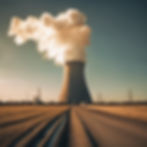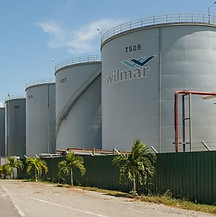
Energy
The energy industry, vital for modern society, generates, distributes, and distributes energy from various sources. As the world transitions towards cleaner energy, challenges like carbon emissions reduction and renewable integration persist. Innovation, infrastructure investment, and policy reforms shape the industry's future.

Different types of energy
Non renewable energy
Non-renewable energy sources, including fossil fuels and nuclear energy, are finite and cannot be replenished on a human timescale. Despite their high energy density and reliability, they contribute significantly to greenhouse gas emissions and environmental pollution.
Coal
A fossil fuel formed from ancient plant matter over millions of years. It is primarily used for electricity generation and industrial processes. Coal combustion releases high levels of carbon dioxide (CO₂), sulfur dioxide (SO₂), and other pollutants, contributing significantly to air pollution and climate change.
Rp 2,60

Oil (petroleum)
A liquid fossil fuel derived from ancient marine organisms. It is refined into products such as gasoline, diesel, and jet fuel. Oil extraction and combustion release CO₂ and can lead to oil spills, which harm marine ecosystems.
Rp 2,30

Natural gas
Composed primarily of methane (CH₄), natural gas is a cleaner-burning fossil fuel used for electricity generation, heating, and as industrial feedstock. While it emits less CO₂ than coal or oil, methane leaks during extraction and transportation are potent contributors to global warming.
Rp 1,70

Nuclear
Generated by splitting uranium atoms in a process called nuclear fission. It produces large amounts of energy with zero direct carbon emissions. While it doesn't emit greenhouse gases during operation, it poses challenges in terms of radioactive waste disposal and potential nuclear accidents.
Rp 2,10

Oil shale
Unconventional oil sources that require extensive processing to extract usable oil. Extraction is energy-intensive, leads to significant habitat destruction, and emits large amounts of greenhouse gases.
Rp 1,10

Renewable energy
Renewable energy, derived from sustainable sources like solar, wind, hydropower, geothermal, and biomass, is crucial for reducing global carbon footprints and combating climate change. Adoption is growing due to technological advancements, cost reduction, and global commitment.
Solar
Captured from sunlight using photovoltaic cells or solar thermal systems, solar energy is used to generate electricity and heat. Clean, abundant, and widely available, it produces no direct emissions. Using Solar panels for homes, solar farms, and solar water heating systems.
Rp 15,00

Wind
Generated by converting wind movement into electricity using wind turbines. Produces zero emissions and can be deployed on land or offshore.
Rp 20,00

Hydropower
Utilizes the flow of water, typically from dams or rivers, to spin turbines and generate electricity. It's reliable and capable of producing large-scale power with low emissions.
Rp 30,00

Geothermal
Harnesses heat from the Earth's interior to produce electricity or provide direct heating. It is reliable and consistent, with low environmental impact.

Biomass
Produced by burning organic materials like wood, agricultural waste, or converting them into biofuels. It can be a carbon-neutral process if managed sustainably.

Tidal and wave
Extracts energy from the movement of tides and ocean waves to generate electricity. It's predictable and sustainable, though still under technological development.

Bioenergy
Bioenergy, derived from biomass, is renewable and offers a cleaner alternative to fossil fuels. Biofuels, produced through fermentation or chemical conversion, are liquid or gaseous fuels like biodiesel and bioethanol.

Different types of bioenergy

Bioethanol
Bioethanol is a biofuel produced by fermenting sugars or starches from plants like corn, sugarcane, and wheat. It's used as an alternative to gasoline or blended with petroleum-based fuels. It's primarily used for transportation and industrial processes, and can be blended with gasoline to reduce dependence on fossil fuels. E85 blends are used in flex-fuel vehicles.

Biodiesel
Biodiesel is a renewable, biodegradable fuel made from organic materials like vegetable oils, animal fats, or recycled cooking oils. It is produced through transesterification, where fats react with alcohol to produce fatty acid methyl esters (FAME). It can be used in transportation, agriculture, and industrial machinery, and can be blended with petroleum diesel for versatility.

Biogas
Biogas is a renewable energy source produced through anaerobic digestion of organic materials by microorganisms. It primarily consists of methane and carbon dioxide, which are highly flammable and suitable for electricity generation, heating, and vehicle fuel. The process can be controlled for efficient production and purified for use in gas engines or turbines.

Syngas
Syngas is a mixture of carbon monoxide, hydrogen, and carbon dioxide produced by gasifying carbon-containing materials. It is produced in a gasifier under high temperatures and pressure, primarily composed of carbon monoxide and hydrogen. Syngas can be burned for electricity or converted into liquid fuels like methanol, ethanol, or synthetic diesel through chemical processes.

BIODIESEL
Biodiesel is a renewable and environmentally friendly alternative to traditional fossil fuels, produced through a chemical process called transesterification. In this process, triglycerides from vegetable oils or animal fats react with an alcohol, typically methanol, in the presence of a catalyst to create fatty acid methyl esters (FAME) and glycerin. Biodiesel can be used in existing diesel engines, offering a sustainable solution for the chemical process industry while reducing greenhouse gas emissions and reliance on non-renewable resources.
Types of biodiesel
01
First generation
Produced from food-based crops.
02
Second generation
Made from non-food biomass.
03
Third generation
Derived from algae, which produce high oil yields and can grow in various environments.
Extraction of Biodiesel

Feedstock Collection and Preparation
-
Commonly used feedstock are vegetable oils (soybean, canola, palm), animal fats, or recycled cooking oils.
-
The feedstock is filtered to remove impurities and water is removed to prevent unwanted side reactions during processing.

Catalyst
-
A strong base like sodium hydroxide (NaOH) or potassium hydroxide (KOH) is used as a catalyst.
-
The catalyst is dissolved in methanol or ethanol to create a methoxide solution.

Transesterification
-
It is a process where triglycerides (fats or oils) react with an alcohol (usually methanol or ethanol) in the presence of a catalyst (such as sodium hydroxide or potassium hydroxide) to produce fatty acid methyl esters (FAME), which is biodiesel, and glycerin as a byproduct.

Separation
-
Ensures that the two main products—biodiesel (fatty acid methyl esters) and glycerin—are isolated.
-
The mixture is allowed to rest in a settling tank for several hours.
-
Due to differences in density, glycerin, being heavier, settles at the bottom, while biodiesel, which is lighter, forms a layer on top.

Washing
-
The biodiesel is washed with warm water to remove any remaining catalyst, alcohol, or soap residues.
-
he biodiesel is then dried to remove any excess water.

Purification and testing
-
The biodiesel is filtered to remove any residual particles.
-
Indonesia's biodiesel quality standards are regulated under SNI (Standar Nasional Indonesia) 7182:2015, which includes purity, viscosity, and other fuel properties.
Companies in Indonesia

PT Wilmar Bioenergi Indonesia
A company that manufactures pure glycerin, which is used in the cosmetics and pharmaceutical industries, and fatty acid methyl esters, or biodiesel, which is widely utilised as fuel.

PT Musim Mas
Musim Mas produces biodiesel derived from environmentally friendly palm oil, which has received various sustainability certifications.

PT Permata Hijau Palm Oleo
Permata Group is a leading fully integrated Palm oil corporation, founded in 1984, with a strong commitment to sustainability and long-term success. With its core business in the Palm oil plantation, Permata Group has evolved into a fully integrated operation that spans the entire palm oil value chain.

Challenge in the Industry
-
Palm oil controversy : Indonesia's biodiesel production relies heavily on palm oil, which raises concerns about deforestation, biodiversity loss, and sustainability issues. This dependence has led to international criticism and pressure for more sustainable practices.
-
Subsidy and pricing issue : The government subsidizes biodiesel to make it competitive with conventional diesel, but fluctuations in global oil prices can create financial strain on subsidy programs.
-
Policy challenge : Frequent changes or delays in the implementation of blending mandates (e.g., B40 by 2025) can create uncertainty for producers and investors.